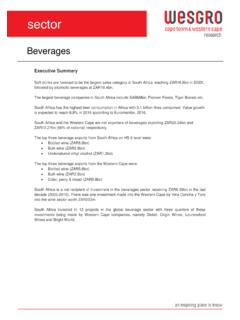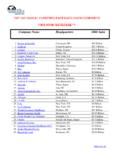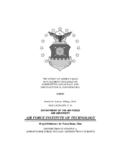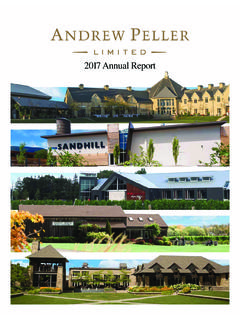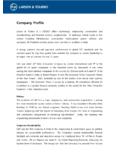Transcription of Kenya - Wesgro
1 Kenya Food and Beverages Executive Summary SECTOR OVERVIEW IN Kenya African countries spend more than USD60bn annually importing food for their growing populations, but the continent has the potential to become a major food exporter. Fresh cow s milk was the leading agricultural product in Kenya valued at in 2013. Food sales over the forecast period will grow by 13%, from in 2016 to KEM2trn in 2020 The largest food sales in Kenya over the five year forecast period to 2020 are expected to be cooking oil and fats (KEM137bn in 2016 to KEM321bn in 2020) and edible oils (KEM129bn in 2016 to KEM307bn in 2020). Kenya s beer sales represented the largest sales of beverages, increasing from 509 million litres in 2012 to a forecasted 791 million litres in 2020. TRADE Kenya is a net exporter of food and beverages. Kenya s exports of food and beverages were valued at in 2014 compared to in 2013, increasing by 20%. South Africa and the Western Cape are net exporters of food and beverages to Kenya .
2 In 2014, South Africa exported food and beverages valued at ZAR673m compared to ZAR513m in 2013, representing an increase of 31%. The leading export product from the Western Cape to Kenya in the food and beverages sector was undenatured ethyl alcohol, valued at ZAR122m. The Western Cape also had a positive trade balance with Kenya from 2004 to 2014. Exports were valued at around ZAR274m in 2014 compared to ZAR236m in 2013, increasing by 16%. In 2014, the leading export product from the Western Cape to Kenya in the food and beverages sector was fresh apples, pears and quinces, valued at ZAR92m. FDI Kenya is a net recipient of FDI in the food and beverage sector. Between January 2003 and August 2015 a total of 36 FDI projects were recorded into the Kenyan food and beverage sector. Between January 2003 and August 2015 a total of 33 FDI projects were recorded into the food and beverage sector by Kenya .
3 These projects represent a total capital investment of Between January 2003 and August 2015 a total of 2 FDI projects were recorded from South Africa into Kenya s food and beverage sector. These projects represent a total capital investment of There were no investments with Kenya in this sector from or into the Western Cape. 2 Table of Contents 1. Definitions/descriptions .. 3 2. Overview of food and beverage market in Kenya .. 3 SWOT analysis of Kenya s food and beverage sector .. 7 Logistics .. 8 Companies .. 9 3. Trade .. 10 Kenya s Global Trade of Food and Beverages .. 10 South African Trade of Food and Beverages with Kenya .. 13 Western Cape Trade of Food and Beverages with Kenya .. 14 Trade Regulations Markings and Standards .. 16 Standards .. 16 Labelling .. 16 Tariffs for South African food and beverages .. 16 4. FDI .. 18 Inward FDI into the Kenyan Food & Beverage Sector .. 18 Outward FDI.
4 19 Bilateral FDI between South Africa and Kenya .. 21 3 1. Definitions/descriptions According to (2012), the food and beverage processing sector refers to the manufacturing, processing and preservation of meat, fish, fruit, vegetables, oils and fats; manufacture of dairy products; manufacture of grain mill products, starches and starch products and prepared animals feeds; manufacture of other food products ( bread, sugar, chocolate, pasta, coffee, nuts and spices); and the manufacture of bottled and canned soft drinks, fruit juices, beer, wines, etc. This analysis includes unprocessed food and beverages such as raw fruit and vegetables, seeds and nuts. African countries spend more than USD60bn annually importing food for their growing populations, but the continent has the potential to become a major food exporter. Large areas of unused arable land, low fertiliser use and poor irrigation mean there is scope for improving yields in Africa, which are among the lowest in the world.
5 A rising middle class continues to boost African demand for food products, especially for processed and packaged food, creating a continental food market that the World Bank estimates could be worth USD1trn in 2030. While exporters in Asia and Brazil stand to gain in the short term, BMI Research (2015) forecasts that food producers, processors and shippers in Kenya and South Africa, and retailers in Nigeria are all well placed to serve the growing African consumer market. 2. Overview of food and beverage market in Kenya Kenya 's food and drink industry will experience robust growth in 2016, as the country's positive economic outlook drives consumer spending. Kenya 's consumer confidence is expected to rise with the increase in household spending due to growing disposable incomes. It is expected that Kenya 's emerging middle class will boost sales for non-essential goods (BMI, 2016). Fresh cow s milk was the leading agricultural product in Kenya valued at in 2013.
6 Indigenous cattle meat and maize were ranked second and third valued at and respectively. Other top products include tea (USD460m), bananas (USD394), potatoes (USD370m) and mangoes and guavas (USD350m) (FAO, 2016). Source: FAOSTAT, 2016 1170229114900348037845984739376437011734 9259319490318297193738185954137955132705 1198321162071149491143691006308688481280 0200 000400 000600 000800 0001 000 0001 200 0001 400 000 Milk, whole fresh cowMeat indigenous, cattleMaizeTeaBananasPotatoesMangoes, mangosteens, guavasMilk, whole fresh camelBeans, drySugar caneTomatoesMeat indigenous, camelAvocadosCabbages and other brassicasCassavaVegetables, fresh nesMeat indigenous, sheepMeat indigenous, goatSweet potatoesEggs, hen, in shellKENYA AGRICULTURAL PRODUCTION (000 USD), 2013 4 Kenya is the East African Community (EAC)'s economic hub and comfortably its most dynamic consumer market. It is expected that robust growth in Kenya 's economy will drive positive growth in the food industry.
7 Kenya 's diversified economy makes it one of the region's best performing, as it is less exposed to the downturn in commodities prices and China's slowdown. Away from Kenya , there are very few countries, if any, in the region that boast such a competitive food retailing industry that is dominated almost entirely by domestic companies (BMI, 2016). Food sales over the forecast period to 2020 will grow by 13%, from in 2016 to KEM2trn in 2020, driven primarily by private consumption growth. The key drives will be the country's rising incomes, growing middle class and favourable demographics, as well as growing financial inclusion. Source: BMI Research, 2016 Kenya 's market is exposed to a booming fast food sector, which will boost growth for convenience foods. Market demand for oils and packaged foods will rise with Kenya 's booming fast food industry and growing need for convenience foods.
8 The long-term opportunities on offer in Kenya , along with the fact that one can source a lot of retail space locally given the relatively well developed nature of the wider food processing industry, suggest Kenya is too good an opportunity to miss (BMI, 2016). The increasing arrival of high-end travellers to Kenya are expected to drive premiumisation in the market and the country's growing number of middle-income consumers will look to spend more on luxury goods offered by international retailers. The largest food sales in Kenya over the five year forecast period are expected to be cooking oil and fats (KEM137bn in 2016 to KEM321bn in 2020), edible oils (KEM129bn in 2016 to KEM307bn in 2020), sugar (KEM153bn in 2016 to KEM248bn in 2020) and beef (KEM145bn in 2016 to KEM233n in 2020). 0001 5002 0002 500 GrowthValue (KEMbn) Kenya FOOD SALES, 2013-2020f 5 Source: BMI Research, 2016 2013201420152016f2017f2018f2019f2020fCoo king oils and oils and animal (fresh), cereal fruits (fresh) fruits (fresh) Salt, spices, and preserved and and Leaf and stem vegetables and (KESbn)TOP 25 Kenya FOOD SALES, 2013-2020f 6 Kenya 's emerging middle-class will be the driver of beer sales, with premium beer experiencing positive growth sales as reported by East African Breweries in H116.
9 Kenyan consumers will switch up from home brewed beer owing to rising disposable incomes to boost the low-end beer market (BMI, 2016). Kenya s beer sales represented the largest sales of beverages, increasing from 509 million litres in 2012 to a forecasted 791 million litres in 2020. This relatively modest growth in volume may cause market leaders to focus on premiumisation, even though the low-cost beer revolution is more established in East Africa than it is in West Africa. Source: BMI, 2016 Whiskey is expected to be the largest alcoholic beverage sales in Kenya over the five-year forecast period to 2020 with million litres being sold in 2020, followed by liqueur and red wine with sales of million litres and million litres respectively. Overall wine consumption in Kenya grew by 5% during 2013, higher than 2012. The growth in wine consumption was largely driven by the growing middle-class population in Kenya (Euromonitor, 2014).
10 There is an opportunity for Western Cape wine companies to promote their wines in this growing market. Kenya Wine Agencies Limited, however, has engaged in extensive marketing and branding to grow and protect its market share amid increased competition (Euromonitor, 2014). Source: BMI, 2016 millionKENYA BEER SALES, Other Fermented millionKENYA ALCOHOLIC BEVERAGE SALES, 2012-2020f 7 Kenya 's tea and coffee industry will drive non-alcoholic drinks sales, as hot drinks sales grow by 11% over the five-year forecast period to 2020. Soft drinks sales will experience positive growth, led by bottled water sales. It is forecasted that mineral or spring water sales will remain high owing to the country's unsafe tap water. Kenya 's growing fast food industry will boost carbonated drinks sales, which are forecast to grow by over our five-year forecast period to 2020 (BMI, 2016). Source: BMI, 2016 SWOT analysis of Kenya s food and beverage sector The table below shows the SWOT analysis of Kenya s food and beverage sector: STRENGTHS WEAKNESSES Kenya is the East African Community (EAC)'s economic hub and comfortably its most dynamic consumer market.
